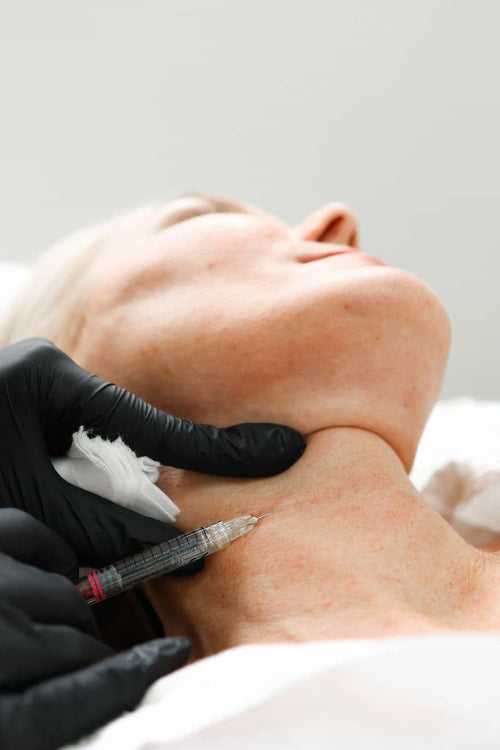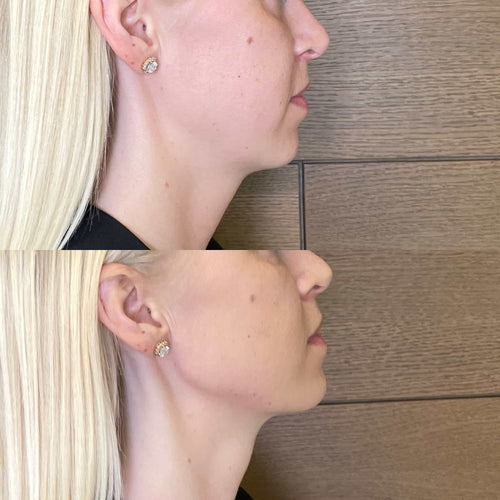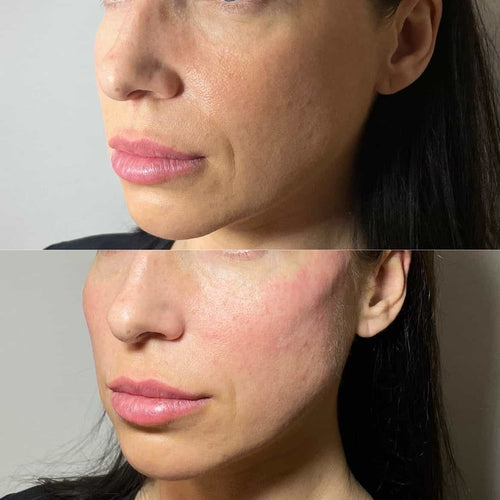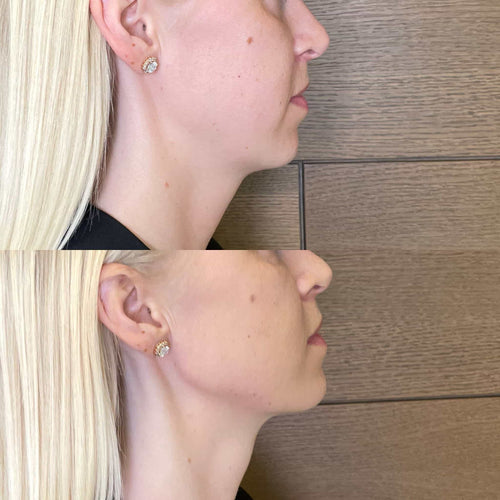Arrange a Dermal Filler Appointment with Dr. Laura Geige
# LongTerm Effects of Lip Fillers
Lip fillers, also known as dermal fillers, are a popular cosmetic treatment used to enhance the appearance of the lips. While they can provide temporary improvements to the shape and size of the lips, there are potential long-term effects to consider.
One of the most common long-term effects of lip fillers is the formation of lumps or nodules under the skin. This occurs when the filler material, usually made from collagen or hyaluronic acid, is not fully absorbed by the body and instead accumulates in a localized area. Nodules can be painful and may require additional treatments to dissolve them.
Another long-term effect of lip fillers is the potential for scarring. When the filler material is injected into the skin, it can cause damage to the surrounding tissue, leading to the formation of a scar. In severe cases, this can lead to permanent disfigurement.
Lip filler migration is another possible long-term effect. This occurs when the filler material shifts over time and moves to other areas of the face or mouth. For example, if a person has lip fillers injected into their lips but then experiences swelling in the corner of their mouth, it may be due to the filler migrating from its original location.
Long-term inflammation is also a potential effect of lip fillers. Some people may experience persistent redness or swelling after receiving lip fillers, which can be caused by an allergic reaction or an adverse immune response to the filler material.
Another long-term effect of lip fillers is the risk of facial asymmetry. When lip fillers are not injected evenly or symmetrically, they can cause one side of the face to appear more voluminous than the other, leading to a lopsided appearance.
Permanent nerve damage is also a rare but possible long-term effect of lip fillers. In some cases, the filler material can irritate or damage nearby nerves, leading to numbness, tingling, or other sensation changes in the lips or surrounding areas.
Lip fillers can also cause chronic dryness and irritation of the lips. This is because the filler material can alter the natural moisture levels of the skin, leading to persistent dryness and discomfort.
Lastly, long-term effects on facial movement and muscle function should be considered as well. Some people may experience numbness or weakness in the muscles surrounding the treated area, making it more difficult to form words or engage in other normal functions.
It is essential for individuals considering lip fillers to carefully weigh these potential long-term effects against the benefits of the treatment and discuss any concerns with a qualified healthcare professional.
General Considerations
Changes in Face Shape and Size
Lip fillers are a popular cosmetic treatment used to enhance the appearance of the lips by increasing their volume, smoothness, and firmness.
Over time, the placement and extent of lip fillers can change due to various factors, including natural aging, hormonal fluctuations, and lifestyle choices. It’s essential to consider these changes when determining where to place lip fillers for optimal results.
A fundamental consideration in lip filler placement is the facial anatomy. The lips are composed of three main layers: the superficial epidermis, the dermis, and the hypodermis. The dermal layer contains blood vessels, nerve endings, and collagen fibers that provide structure and support to the lips.
The placement of lip fillers should take into account the face shape and size of the patient’s face. For example, individuals with a round or oval face shape may require more subtle fillers in the Cupid’s bow area to avoid accentuating the facial fullness.
Patient with a square face shape may benefit from fillers placed along the _central_ lip line, as this can help soften the angular features and create a more balanced appearance. On the other hand, individuals with a square or heart-shaped face may require more filler in the Cupid’s bow area to create a sense of harmony.
The size of the patient’s lips is another crucial factor to consider when determining lip filler placement. Individuals with smaller lips may benefit from more extensive fillers, while those with larger lips may require less filler to achieve the desired shape and volume.
Another important consideration is the natural lip movement. Fillers placed too close to the surface of the skin can cause discomfort, swelling, or numbness during movements. To avoid these complications, it’s essential to consider the patient’s natural lip movement patterns when determining filler placement.
Finally, it’s essential to consider the lifestyle choices that may impact lip filler longevity. Factors such as smoking, sun exposure, and excessive facial expressions can all contribute to lip filler degradation over time.
In general, lip fillers can last anywhere from several months to a few years depending on various factors, including the type of filler used, the skill of the practitioner, and individual patient characteristics.
The most common types of lip fillers used include hyaluronic acid (e.g., Restylane, Juvederm), _calcium hydroxylapatite_ (e.g., Radiesse), and autologous fat transfer. Each type of filler has its unique properties and benefits, and the choice of filler should be tailored to the individual patient’s needs and preferences.
Overall, determining where lip fillers go over time requires a thorough understanding of facial anatomy, face shape and size, natural lip movement, lifestyle choices, and the type of filler used. By considering these factors and working with an experienced practitioner, patients can achieve optimal results and enjoy longer-lasting lip filler effects.
Lip fillers can lead to changes in the overall shape and size of the face, as they are injected into specific areas. According to a study by the University of California, Los Angeles (UCLA), lip fillers can cause the face to appear more rounded, particularly when used on the lower lip.
Lip fillers can lead to changes in the overall shape and size of the face, as they are injected into specific areas.
The effects of lip fillers on facial shape and size can be permanent, depending on the type and amount of filler used.
- The nose: Injecting fillers into the nose can temporarily increase its size or alter its shape. However, this effect is usually reversible with the use of hyaluronidase, an enzyme that breaks down fillers.
- The cheeks: Filler injections in the cheeks can cause them to appear fuller or more prominent, especially if the filler is injected too close to the nasal bone.
- The chin: Fillers injected into the chin can increase its size, which may alter the overall facial proportion and balance.
- The lips: Lip fillers can change the shape and size of the lips, making them appear fuller or more plump. However, overuse of lip fillers can lead to an unnatural appearance.
Reserve Your Dermal Filler Consultation with Dr. Laura Geige Now
A study by the University of California, Los Angeles (UCLA), found that lip fillers can cause the face to appear more rounded, particularly when used on the lower lip.
The researchers concluded that this is because the lower lip plays a crucial role in defining the contours of the face, and altering its shape with fillers can have a ripple effect on the overall facial structure.
Other studies have also investigated the long-term effects of lip fillers on facial shape and size. For example, one study published in the Journal of Plastic, Reconstructive & Aesthetic Surgery found that lip filler injections can cause scarring, granulomas, or other complications, especially if the procedure is not performed by an experienced practitioner.
Another study published in the Aesthetic Plastic Surgery journal found that lip fillers can affect the facial nerve and cause numbness, tingling, or other neurological symptoms, particularly if the filler is injected too close to the nerve.
Overall, while lip fillers can be an effective way to enhance facial appearance, it’s essential for patients to carefully weigh the potential risks and benefits and choose a qualified practitioner to administer the treatment.
Loss of Facial Contours
One of the most common concerns with facial fillers is the loss of facial contours over time.
This phenomenon can be attributed to various factors, including the natural aging process, muscle movement, and filler material degradation.
The primary cause of loss of facial contours is the atrophy of the underlying tissue that was initially filled by the cosmetic injectable.
As the body breaks down the filler material, it can lead to a gradual resorption of the substance, resulting in a loss of volume and definition.
This process is accelerated when the treated area is subjected to constant stress or strain, such as smiling, frowning, or talking.
The extent of facial contour loss can vary depending on several factors, including the type of filler used, its longevity, and individual patient characteristics.
For example, fillers like hyaluronic acid tend to break down faster than those composed of calcium-based compounds, such as calcium hydroxylapatite.
Additionally, patients with a higher muscle activity in the treated area are more likely to experience facial contour loss over time.
The rate at which facial contours are lost can be influenced by multiple factors, including:
• Age: As individuals age, their skin and underlying tissue undergo natural changes that contribute to facial contour loss.
• Muscle movement: Repeated muscle contractions in the treated area can lead to facial contour loss over time.
• Filler material degradation: The breakdown of filler materials can result in a gradual loss of volume and definition.
• Patient lifestyle: Habits such as smoking, excessive sun exposure, and poor nutrition can all contribute to facial contour loss.
A comprehensive evaluation by a qualified healthcare professional is essential to determine the best course of treatment and minimize the risk of facial contour loss over time.
This may involve using advanced filler technologies, incorporating adjunctive treatments like botulinum toxin injections, or employing customized regimens tailored to individual patient needs.
By understanding the causes of facial contour loss and implementing effective prevention strategies, individuals can maintain a more youthful appearance and enhance their overall confidence.
A thorough understanding of these considerations is essential for creating realistic expectations and achieving optimal results with facial fillers.
Excessive use of lip fillers can result in the loss of facial contours, leading to a softer appearance. The American Academy of Dermatology notes that this can be caused by uneven distribution or excessive filling material.
Lip fillers are a popular cosmetic treatment used to add volume and shape to the lips, but like any other facial feature, they can undergo changes over time. One of the main concerns with lip fillers is that excessive use can lead to a loss of facial contours, resulting in a softer appearance.
This phenomenon can be attributed to several factors, including uneven distribution or excessive filling material. When lip fillers are injected into the lips, they are intended to enhance the natural shape and volume of the pout. However, if the filler is overfilled or distributed unevenly, it can cause the lips to become puffy, lopsided, or asymmetrical.
Moreover, as the body metabolizes the filler material, it can break down and be absorbed, leading to a loss of volume and contours. This process can be accelerated by excessive use of lip fillers, which can stimulate an overproduction of collagen and elastin in the lips. While this may provide temporary results, it can also lead to an unnatural, lumpy texture that detracts from the natural beauty of the face.
The American Academy of Dermatology emphasizes the importance of moderation when using lip fillers. They note that even with proper technique and dosing, lip fillers can have adverse effects if used excessively or improperly. For instance, excessive use can cause permanent scarring, swelling, or bruising around the injection site.
Furthermore, lip fillers are not suitable for everyone, particularly those with certain medical conditions, such as high blood pressure, bleeding disorders, or autoimmune diseases. Additionally, individuals with a history of skin cancer, lupus, or rosacea may need to exercise caution when considering lip filler treatments.
To minimize the risk of adverse effects and ensure optimal results, it is essential to consult with a qualified, experienced practitioner who has a good understanding of the latest techniques and best practices. A thorough consultation will help determine whether lip fillers are suitable for your individual needs and goals.
Ultimately, lip filler treatments should be used judiciously and as part of a comprehensive skincare routine that prioritizes natural beauty, healthy skin, and overall facial balance. By being aware of the potential risks and consequences associated with excessive use, individuals can make informed decisions about their lip filler treatments and enjoy optimal results for years to come.
Factors Influencing Lip Filler Placement and Effectiveness
Individual Variations in Anatomy
The placement of lip fillers and their effectiveness can vary significantly from one individual to another, influenced by a complex interplay of anatomical, physiological, and cosmetic factors.
- Genetic predisposition plays a significant role in determining the natural shape and structure of the lips. Some people may have naturally fuller or more Cupid’s bow prominent lips, which can affect where lip fillers are most effective.
- Facial asymmetry is another factor to consider. If one side of the face is significantly more prominent than the other, lip filler placement should be adjusted accordingly to achieve balanced results.
- The shape and size of the lips will also influence where lip fillers are most effective. For example, if a person has thin or unevenly shaped lips, fillers may need to be placed in specific areas to enhance volume and create a more symmetrical appearance.
- Individual variations in facial bone structure can also impact lip filler placement. A person with a prominent jawline or facial projection may require different types of fillers or placements to avoid overwhelming the lips.
Anatomical variations such as differences in lip shape, size, and skin elasticity also play a crucial role in determining where lip fillers are most effective. For instance:
- Vertical lip lines may require special consideration when placing fillers. Fillers placed too close to the line may accentuate its appearance.
- Lip border shape and size can be affected by the type of filler used, with some products more suitable for certain individuals than others.
- Pursed-lips individuals (those who frequently purse their lips) may experience less effective results or increased filler wear due to lip movements.
The placement of lip fillers also affects their effectiveness, depending on factors such as:
- The type and amount of filler used: Different products have varying levels of longevity, durability, and distribution. Some may last longer than others but still require repeat treatments.
- Location within the lips: Fillers placed in areas with high lip movement (e.g., outer corners) tend to work best when injected deeper rather than superficially.
- The skill level of the practitioner performing the procedure: A highly experienced injector is crucial for achieving optimal results and minimizing complications.
Additionally, individual variations in skin elasticity and firmness can impact lip filler effectiveness. For example:
- Skin with low collagen production may not retain fillers as well as skin with higher collagen levels, resulting in shorter-lasting effects.
- Lip skin texture and tone: Dull or uneven skin tones can affect the appearance of lip fillers and reduce their overall effectiveness.
Understanding these factors is crucial for achieving optimal results from lip filler treatments. A well-informed injector will consider each individual’s unique anatomy, lifestyle, and cosmetic goals to create a personalized treatment plan that enhances the natural beauty of their lips.
Individual variations in anatomy, such as the size and shape of the lips, can affect the placement and effectiveness of lip fillers. According to a study published by the Journal of Cosmetic Dermatology, the use of customized implant designs can help improve outcomes.
Lip filler placement and effectiveness can be influenced by various factors, including individual variations in anatomy.
These variations can affect how lip fillers behave over time, leading to unpredictable outcomes if not properly planned.
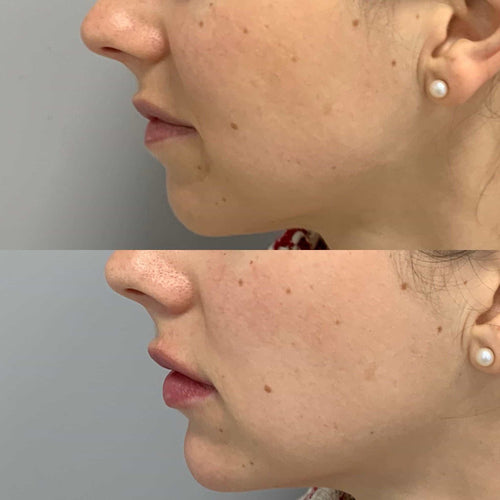
The size and shape of the lips are crucial considerations when determining where to place lip fillers.
Lips come in different shapes and sizes, with some having a more pronounced cupid’s bow or outer edge than others.
This natural variation can impact how well lip fillers work, as the filler may be more visible in some cases than others.
A study published by the Journal of Cosmetic Dermatology found that customized implant designs can help improve outcomes when it comes to lip filler placement.
The researchers noted that a one-size-fits-all approach often leads to suboptimal results, as lip fillers may not be distributed evenly across the lips.
Customized implants, on the other hand, can be designed to complement an individual’s unique anatomy, leading to more natural-looking results.
When choosing a lip filler placement location, it’s essential to consider the patient’s facial features and overall aesthetic goals.
The location of the filler injection site can greatly impact the final result, with some areas being more prone to visibility or movement than others.
Filler placement in the central portion of the lips is often preferred for its natural appearance, as it allows for a symmetrical balance between the two lips.
However, this location may not be suitable for everyone, particularly those with smaller lip sizes or more pronounced facial asymmetry.
In such cases, filler placement in the outer corners of the lips or along the Cupid’s bow can create a more balanced appearance and draw attention away from any lip imperfections.
Another critical factor to consider when evaluating the effectiveness of lip fillers is their ability to provide long-term results.
Lip fillers, particularly hyaluronic acid-based products, have become increasingly popular due to their temporary nature and reversible effects.
This allows individuals to easily correct or adjust their lip filler placement if needed, without the need for surgery or a prolonged recovery period.
However, this temporary nature also means that fillers may require repeated injections to maintain desired results, which can impact their overall effectiveness over time.
The type and quantity of lip filler used also plays a significant role in determining placement and effectiveness.
A general rule of thumb is to use the smallest amount necessary to achieve the desired result, as excessive fillers can lead to an unnatural appearance and may cause discomfort or complications.
On the other hand, using too little filler may not provide sufficient results, leading to dissatisfaction with the treatment outcome.
A more precise approach to lip filler placement involves taking into account individual anatomical variations and aesthetic goals.
This may involve a thorough consultation with a qualified healthcare professional or dermatologist to determine the most effective placement strategy for each patient.
Using advanced imaging technologies, such as 3D scanning or photo mapping, can also help healthcare professionals accurately assess lip shape, size, and proportions prior to treatment.
This information can be used to create a customized treatment plan that takes into account the unique characteristics of the individual’s lips.
Ultimately, effective lip filler placement requires a comprehensive understanding of both anatomy and aesthetics.
A skilled healthcare professional must balance these factors to achieve the most natural-looking results, taking into account the patient’s individual needs and goals.
This careful consideration ensures that lip fillers provide optimal benefits while minimizing potential risks or complications.
Skill and Experience of the Injector
The placement and effectiveness of lip fillers can be influenced by a multitude of factors, which are essential to consider when undergoing treatment.
1. Anatomical Individuality: Each person’s face is unique, with distinct facial features and proportions. The shape and size of the lips, as well as the surrounding bone structure, play a significant role in determining the ideal placement of lip fillers. A skilled injector must take into account these individual variations to achieve natural-looking results.
2. Desired Lip Shape and Size: The type of filler used (e.g., hyaluronic acid, calcium hydroxylapatite, or polymethylmethacrylate) and the desired lip shape and size can impact the placement of fillers. For example, a rounder lip shape may require more filler in the central portion, while a more defined Cupid’s bow may necessitate less filler.
3. Skin Elasticity and Texture
– Skin elasticity is crucial when it comes to lip filler placement. A firm skin texture can allow for more precise injections, resulting in a more natural appearance. On the other hand, loose or saggy skin may require additional support or different injection techniques.
4. Nerve Sensation: The sensation of nerve endings in the lips and surrounding area can influence the placement of fillers. Areas with high nerve density, such as the cupid’s bow or vermilion border, should be approached with caution to avoid discomfort or numbness.
5. Injector Skill and Experience
– A skilled injector is essential for achieving optimal results with lip filler placement. With experience, an injector can develop a keen sense of where fillers will distribute and how they will interact with surrounding tissues.
6. Filler Type and Quantity
– Different types of fillers have varying properties and shelf lives, which impact their effectiveness and potential for complications. For example, hyaluronic acid fillers tend to be more versatile, while calcium hydroxylapatite fillers are often used for more permanent results.
7. Patient Expectations
– Clear communication between the injector and patient is vital in ensuring that lip filler placement aligns with the patient’s desired outcome. Patients should be informed about potential risks, benefits, and realistic expectations to avoid disappointment or dissatisfaction.
8. Aging Process
– As individuals age, their lips naturally undergo changes, including volume loss and sagging. To address these concerns, an injector may need to adjust filler placement accordingly, using more strategic injection techniques to maintain a youthful appearance.
9. Comorbidities and Medications
– Certain medical conditions or medications can affect lip health, influencing the success of lip filler treatment. For instance, individuals taking anticoagulant medications may be at risk for excessive bleeding during procedures.
10. Aftercare and Maintenance
– Proper aftercare and maintenance are essential for ensuring optimal results from lip fillers. Patients should follow recommended guidelines for post-procedure care, including avoiding certain activities and maintaining a healthy lifestyle to maintain the desired appearance.
The skill and experience of the injector also play a significant role in the longterm effects of lip fillers. A study by the International Society of Aesthetic Plastic Surgery found that injectors with more years of experience had better outcomes.
Lip fillers are a popular cosmetic treatment used to enhance the shape and appearance of the lips, but like any other injection-based procedure, their placement and effectiveness can vary greatly depending on several factors.
One of the key factors influencing lip filler placement is the individual’s anatomy. The shape and size of the mouth, the natural curve of the lips, and the amount of fat in the lower lip all play a role in determining where to place the fillers for optimal results.
Another crucial factor is the type of lip filler used. Different materials, such as hyaluronic acid (HCA), calcium hydroxylapatite, and poly-L-lactic acid (PLLA), have varying textures, densities, and durability, which can affect the longevity and comfort of the treatment.
- Volume and symmetry:** The amount of filler used and the symmetry of the lips are critical factors in achieving a natural-looking result. Injectors must assess the patient’s lip anatomy to determine the optimal volume and placement of fillers.
- Filler migration:** Over time, the body can cause lip fillers to migrate to other areas, which can lead to an unnatural appearance. The risk of filler migration is higher if the correct technique is not used or if the patient is not a good candidate for the procedure.
- Sensory nerve distribution:** The placement of fillers must take into account the sensory nerve distribution in the lip area. Injecting too close to sensitive areas can cause discomfort, pain, or numbness, which may be permanent.
The skill and experience of the injector also play a significant role in the long-term effects of lip fillers. A study by the International Society of Aesthetic Plastic Surgery found that injectors with more years of experience had better outcomes.
This is not surprising, as experience and expertise allow injectors to:
- Assess the patient’s anatomy accurately
- Choose the right filler for each individual
- Use proper technique to minimize complications and maximize results
- Evaluate and adjust their techniques over time based on patient feedback and outcomes
In addition, more experienced injectors are better equipped to handle common complications, such as filler overcorrection or undercorrection, which can be difficult to correct if not caught early.
The study also found that injectors with less experience were associated with a higher rate of filler-related complications, such as swelling, bruising, and asymmetry.
Overall, the success of lip fillers depends on various factors, including anatomy, filler type, volume, symmetry, sensory nerve distribution, injector skill, and experience. Patients should carefully research and choose an experienced injector who has a track record of excellent results to ensure optimal outcomes.
Maintenance and Replacement
Natural Atrophy and Reabsorption
Maintenance and replacement of lip fillers are essential to maintain their effectivity and ensure a natural-looking outcome.
After receiving lip filler injections, it’s crucial to follow post-injection instructions carefully, including avoiding strenuous activities, smoking, and excessive sun exposure.
During the initial stages after injection, the body may react to the filler by causing minor swelling, redness, or bruising, which are usually temporary and resolve on their own within a few days.
However, with regular maintenance, most lip fillers can last anywhere from 6 months to 2 years, depending on various factors such as lifestyle, genetics, and individual metabolism.
The type of filler used also plays a significant role in determining the lifespan of the results. For example, hyaluronic acid fillers tend to break down faster than calcium hydroxylapatite or polymethylmethacrylate (PMMA) fillers.
Natural atrophy refers to the gradual decrease in size and firmness of the lips over time due to various factors such as aging, sun exposure, genetics, and lifestyle choices.
Reabsorption occurs when the body’s immune system identifies lip filler particles as foreign objects and gradually breaks them down, often leading to a gradual loss of volume and shape.
Avoiding extreme temperatures, using sunscreen, and not smoking can help minimize natural atrophy and reabsorption, ultimately preserving the results of lip filler treatments.
Additionally, some patients may experience re-absorbed fillers in certain areas, such as the philtrum or Cupid’s bow, due to their unique anatomical structures.
Careful placement and selection of lip fillers can reduce the likelihood of complications, including uneven distribution, lumps, or asymmetry.
Adequate maintenance through regular touch-ups and monitoring by a qualified practitioner is essential for achieving optimal results and maintaining natural-looking lips over time.
Lip fillers are not permanent and can be reabsorbed or atrophied over time. The FDA notes that the body may absorb lip fillers, leading to a loss of volume.
Lip fillers are designed to provide temporary enhancement to the lips, but their longevity and stability can be a topic of concern for many individuals.
The body’s natural processes play a significant role in determining where lip filler goes over time.
Additionally, the type of lip filler used can also affect its longevity and stability. For example:
It’s essential to note that the exact duration of lip filler longevity depends on individual factors such as:
To maintain optimal results and extend the longevity of lip fillers, it is recommended to:
Follow-Up Appointments and Touch-Ups
Lip fillers are a popular cosmetic treatment used to enhance the appearance of lips by adding volume, shape, and smoothness. However, like any other cosmetic treatment, lip fillers have a limited lifespan and require maintenance and replacement to maintain their effectiveness.
During the initial procedure, lip filler is injected into the lip tissue using a specialized needle or cannula. The filler material, usually made of hyaluronic acid or collagen, is designed to mimic the natural lip structure and provide long-lasting results.
However, over time, the lip filler begins to break down naturally in the body. This process can be accelerated by factors such as aging, sun exposure, smoking, and repeated lip movements. As a result, the lip filler may start to fade, lose its shape, or become uneven.
This is where maintenance and replacement come into play. To maintain the desired results, it’s essential to schedule follow-up appointments with a qualified practitioner every 3-6 months, depending on individual factors such as skin type, lip size, and filler material used.
During these appointments, the practitioner will assess the lip area and adjust or replace the existing filler as needed. This process is called “touch-ups.” The goal of touch-ups is to maintain the natural shape, symmetry, and volume of the lips while preventing further settling or migration of the filler.
A skilled practitioner will use a combination of techniques and products to restore the lip area to its original shape and appearance. This may involve injecting new filler material, adjusting existing filler, or using other cosmetic treatments such as lip enhancements or lip lifts.
In some cases, more extensive procedures may be necessary to achieve optimal results. For example, if the lip filler has fully dissolved, a replacement procedure may be required to restore the desired shape and volume of the lips.
It’s essential to note that maintenance and replacement should be done under the guidance of a qualified practitioner to avoid complications, unevenness, or an unnatural appearance. Improper injection techniques, inadequate touch-ups, or over-reliance on filler material can lead to unwanted results, such as lip asymmetry, numbness, or scarring.
Properly performed maintenance and replacement procedures can help maintain the effectiveness of lip fillers and achieve long-lasting, natural-looking results. By scheduling regular follow-up appointments with a qualified practitioner, individuals can ensure that their lips remain smooth, plump, and beautiful over time.
Regular followup appointments and touchups are necessary to maintain the desired results of lip fillers. According to a study by the Journal of Cosmetic Surgery International, maintenance injections can help maintain lip shape and size.
Maintenance and Replacement are crucial steps to maintain the desired results of lip fillers, as they help to restore the original shape and size of the lips over time.
Regular follow-up appointments with a licensed practitioner are necessary to monitor the effects of the lip fillers and address any changes or concerns that may arise. During these appointments, the practitioner will assess the lips for any signs of wear, tear, or changes in shape, and make adjustments as needed.
The American Society of Plastic Surgeons recommends that patients return to their practitioner every 6-12 months for touch-ups, depending on the type and amount of filler used. This frequency helps to maintain the desired results and prevent significant changes in lip shape and size.
A study published by the _Journal of Cosmetic Surgery International_ found that maintenance injections can help maintain lip shape and size over time. The study concluded that regular follow-up appointments with a licensed practitioner are essential for achieving optimal results from lip fillers.
Some key indicators that require replacement or touch-ups include:
- Gradual decline in lip volume
- Changes in lip shape, such as asymmetry or unevenness
- Loss of natural lip contour and definition
- Maintenance of optimal results requires regular monitoring and adjustments.
Get Your Dermal Filler Consultation with Dr. Laura Geige at It’s Me and You Clinic
The type of filler used also plays a significant role in determining the frequency of maintenance appointments. For example:
- _Hyaluronic acid fillers_ (e.g., Juvederm, Restylane), which typically require maintenance every 12-18 months.
- _Calcium hydroxylapatite fillers_ (e.g., Radiesse), which may require maintenance every 6-12 months.
It’s essential to note that the frequency of maintenance appointments may vary depending on individual factors, such as lifestyle, diet, and overall health. Patients should consult with their practitioner to determine a personalized schedule for maintenance and replacement of lip fillers.
A thorough understanding of the importance of maintenance and replacement is crucial for achieving optimal results from lip fillers. By scheduling regular follow-up appointments and touch-ups, patients can ensure that their lips maintain their desired shape and size over time.
Read more about Elizabeth Joy Photo here. Read more about Live Your Vows here. Read more about I Like Corbyn But here. Read more about Canniant here. Read more about One One Three Online here. Read more about The First Come First Served here.

